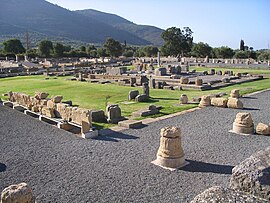
Back Messene ALS ميسيني Arabic Месена Bulgarian Messene Catalan Messene Czech Messene Danish Messene German Αρχαία Μεσσήνη Greek Mesene Spanish مسینی FA
Ancient Messene
Αρχαία Μεσσήνη | |
|---|---|
 View of the ancient Asclepeion. | |
| Coordinates: 37°10.5′N 21°55.2′E / 37.1750°N 21.9200°E | |
| Country | Greece |
| Administrative region | Peloponnese |
| Regional unit | Messenia |
| Municipality | Messini |
| Municipal unit | Ithomi |
| Elevation | 402 m (1,319 ft) |
| Population (2021)[1] | |
• Community | 181 |
| Time zone | UTC+2 (EET) |
| • Summer (DST) | UTC+3 (EEST) |
| Postal code | 240 02 |
Messene (Greek: Μεσσήνη 𐀕𐀼𐀙 Messini), officially Ancient Messene, is a local community within the regional unit (perifereiaki enotita) of Messenia in the region (perifereia) of Peloponnese.[2]
It is best known for the ruins of the large classical city-state of Ancient Messene. The site was founded in the Bronze Age as Ithome, an ancient city originally of Achaean Greeks which eventually came under the hegemony of the military state of Sparta with which it had a long struggle. During the latter period many inhabitants went into exile, and eventually it was destroyed by the Spartans and abandoned for some time.
After the defeat of the Spartans at the Battle of Leuctra (371 BC), the Thebans invaded the Peloponnese[3] and Epaminondas built the new city of Messene on the site in 369 BC over the ruins of Ithome and invited the return of the previous inhabitants and their descendants.
The substantial ruins are a major historical attraction. Much has been archaeologically excavated and partly restored or preserved for study and public viewing, as well as for various events. The most substantial restored remains being those dating from the Hellenistic and Roman times.
The city of Messene flourished also in the postclassical times and a settlement at the site continued until modern times. Late Roman Messene suffered much after the major AD 365 Crete earthquake that hit hard also the entire SW Peloponnese.[4] From the beginning of the 5th century AD Messene is being reconstructed as a Christian city and the seat of a local bishop. It will be in the so called Byzantine "Dark-Ages" during the 7th and 8th centuries that the city once again experienced a deep crisis with the settlement of new populations in the region, probably of Slavic origin. In Middle Byzantine times, after the 10th century, the now called village or township of Voulcano experiences new growth with rich material remains. The village of Voulcano/Messene continues through the Late Medieval/Frankish and Ottoman periods until Early Modern times when the village changes name again into Mavromati, that still occupies what was the upper city around the ancient fountain identified as Klepsydra.
- ^ "Αποτελέσματα Απογραφής Πληθυσμού - Κατοικιών 2021, Μόνιμος Πληθυσμός κατά οικισμό" [Results of the 2021 Population - Housing Census, Permanent population by settlement] (in Greek). Hellenic Statistical Authority. 29 March 2024.
- ^ "ΦΕΚ B 1292/2010, Kallikratis reform municipalities" (in Greek). Government Gazette. p. 17436.
- ^ Chisholm 1911.
- ^ N. Tsivikis, An Early End to Antiquity in Roman Provincial Greece: Pagans and Christians in the Wake of the 365 CE Earthquake in Messene, CHS Research Bulletin 9 (2021).
